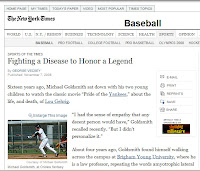
http://www.nytimes.com/2008/11/08/sports/baseball/08vecsey.html?em
From the November 8, New York Times --
November 8, 2008
Sports of The Times
Fighting a Disease to Honor a Legend
By GEORGE VECSEY
Sixteen years ago, Michael Goldsmith sat down with his two young children to watch the classic movie “Pride of the Yankees,” about the life, and death, of Lou Gehrig.
“I had the sense of empathy that any decent person would have,” Goldsmith recalled recently. “But I didn’t personalize it.”
About four years ago, Goldsmith found himself walking across the campus at Brigham Young University, where he is a law professor, repeating the words amyotrophic lateral sclerosis. He did not know why he was saying the words. They just came to his mind. A year or so later, he began having twinges.
Goldsmith was never a Yankees fan. Growing up in Forest Hills, Queens, he adopted the Baltimore Orioles when they made a run at the Yankees in 1960, and has stayed with the Orioles ever since. He says he always admired Gehrig more than any other Yankee, as a great player as well as a man who lived and died with grace.
Now Michael Goldsmith is fighting the condition, A.L.S., also known as Lou Gehrig’s disease — “a progressive neurodegenerative disease that affects nerve cells in the brain and the spinal cord,” in the words of the A.L.S. Association. It is invariably fatal, usually within four years.
Many people are taking on the cause of fighting the disease, in their own ways. By some strange coincidence, I recently heard about a small group called 2175 for A.L.S., based in the Washington area, which is raising funds by having an endurance athlete, Ben Davis, hike the length of the Appalachian Trail.
The other night I talked to Davis by telephone after he had been in Virginia completing 50 of the trail’s 2,175 miles, spotting a small black bear along the path. He told me he had become committed to fighting A.L.S. after watching Bill Jackson, a chef at the restaurant he manages, die of the disease. Now, he seeks donations for every mile he covers, following the autumn leaves southward from Maine to Georgia. You can follow his progress on www.2175forALS.com.
Davis, 28, and his support man, Rick Cheever, 25, said they had not seen “Pride of the Yankees” and did not know much about Gehrig. But they know about the disease that killed Gehrig in 1941, and that is what matters.
As a 57-year-old New Yorker and a sports fan, Goldsmith knows about Gehrig. He once heard that there was a private corner under the stands of Yankee Stadium where Gehrig went to cry after learning why his motor skills had vanished so suddenly.
Goldsmith, who has a slower version of the disease, has been able to keep going, three years past the first signs that his body was failing. He continues to teach law classes (“I am known as a racketeering specialist,” he said) and has pursued his connection with Lou Gehrig’s sport, his sport.
After playing baseball in Queens as a child, Goldsmith later picked it up in his 30s in an amateur league, against former college and minor league players, learning to switch-hit and becoming a better player than he had ever been. Early this year, he attended a fantasy camp run by his favorite team. The former Orioles Jeff Tackett and Bill Swaggerty worked with Goldsmith, pushing him onward with basic ballplayer humor: “They never let me get maudlin,” Goldsmith said.
Back in his adopted home in Utah, Goldsmith was hauled off to the batting cage by Gary Pullins, a former baseball coach at Brigham Young, who threw batting practice. The arm muscles were weakened, but Pullins showed him to get more power from his back and butt muscles.
Praising the A.L.S. Therapy Development Institute of Cambridge, Mass., Goldsmith says there is a great need for more research into the disease. For example, he said that when he asked if his normal strenuous workout was good for an A.L.S. patient, some doctors said they did not know. He decided to keep swimming a quarter-mile a day and pushing himself.
Goldsmith now has a proposal: in a guest column in the Nov. 10 issue of Newsweek, he suggested that Major League Baseball help raise funds for research by honoring Gehrig on the 70th anniversary of his retirement, next July 4. So far, he hasn’t heard from M.L.B.
As the nominal national pastime, baseball has gotten great mileage out of its legends, including the enduring film, made in 1942, a year after Gehrig’s death. The screenwriters took Gehrig’s opening line and moved it to the end of the speech, but Gehrig, a former Columbia University student, actually began his talk this way: “Fans, for the past two weeks, you have been reading about a bad break. Yet today, I consider myself the luckiest man on the face of the earth.”
Having gained from its eloquent hero, baseball would do well to listen to Goldsmith’s suggestion by honoring Gehrig, and all those who fight A.L.S., one way or the other, next July 4.

No comments:
Post a Comment